Comprehensive Analysis of Organizational Behavior at 4C Company
VerifiedAdded on 2020/10/05
|13
|4574
|209
AI Summary
This comprehensive analysis examines the organizational behavior at 4C Company by focusing on key aspects such as leadership styles, employee engagement, and company culture. The study explores how different leadership approaches influence workplace dynamics and employee performance. It investigates strategies for enhancing employee motivation and satisfaction, which are crucial for maintaining high levels of productivity and morale. Additionally, the analysis delves into the cultural practices within 4C Company, assessing their alignment with organizational goals and values. By understanding these elements, this assignment aims to provide insights into how effective management and a positive workplace environment contribute to overall business success.
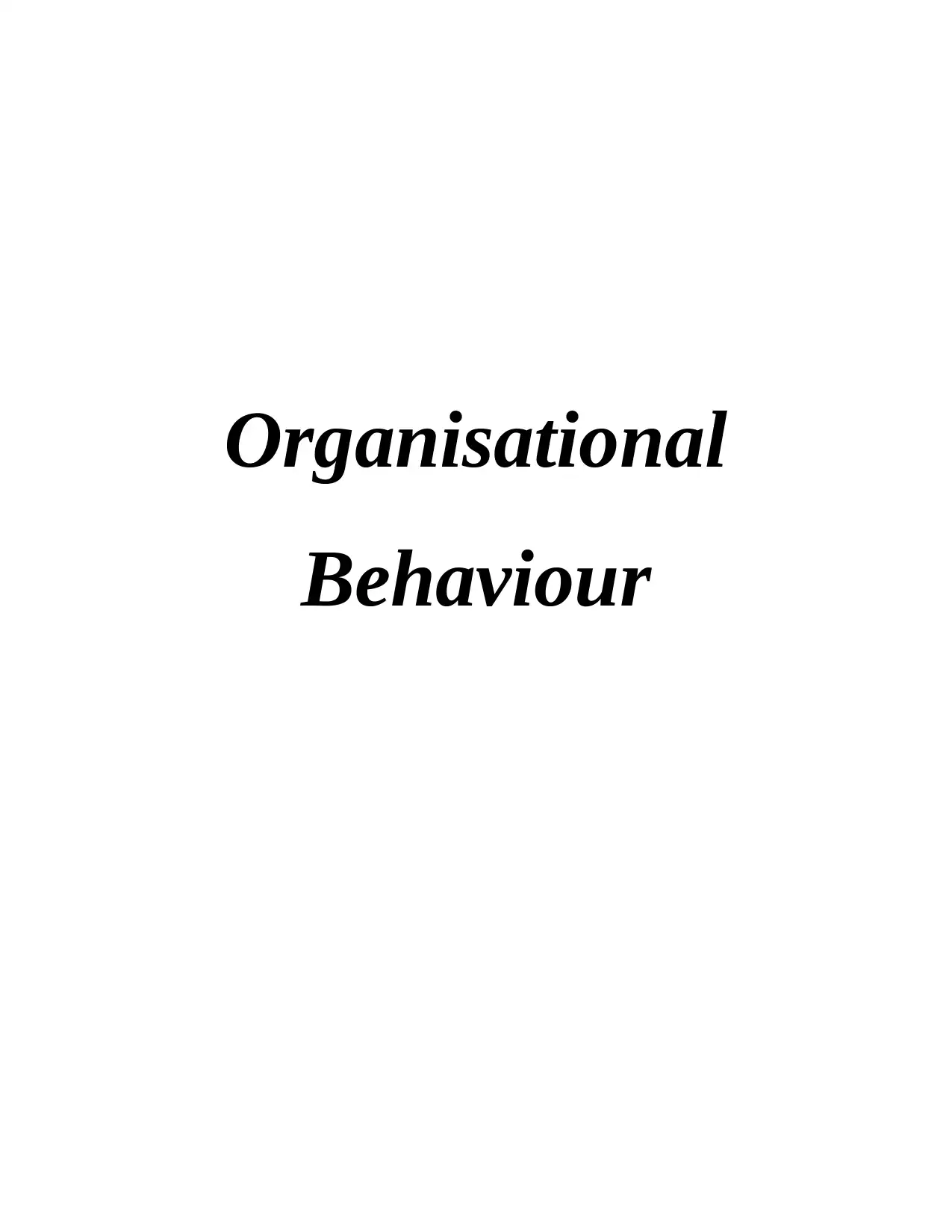
Organisational
Behaviour
Behaviour
Paraphrase This Document
Need a fresh take? Get an instant paraphrase of this document with our AI Paraphraser
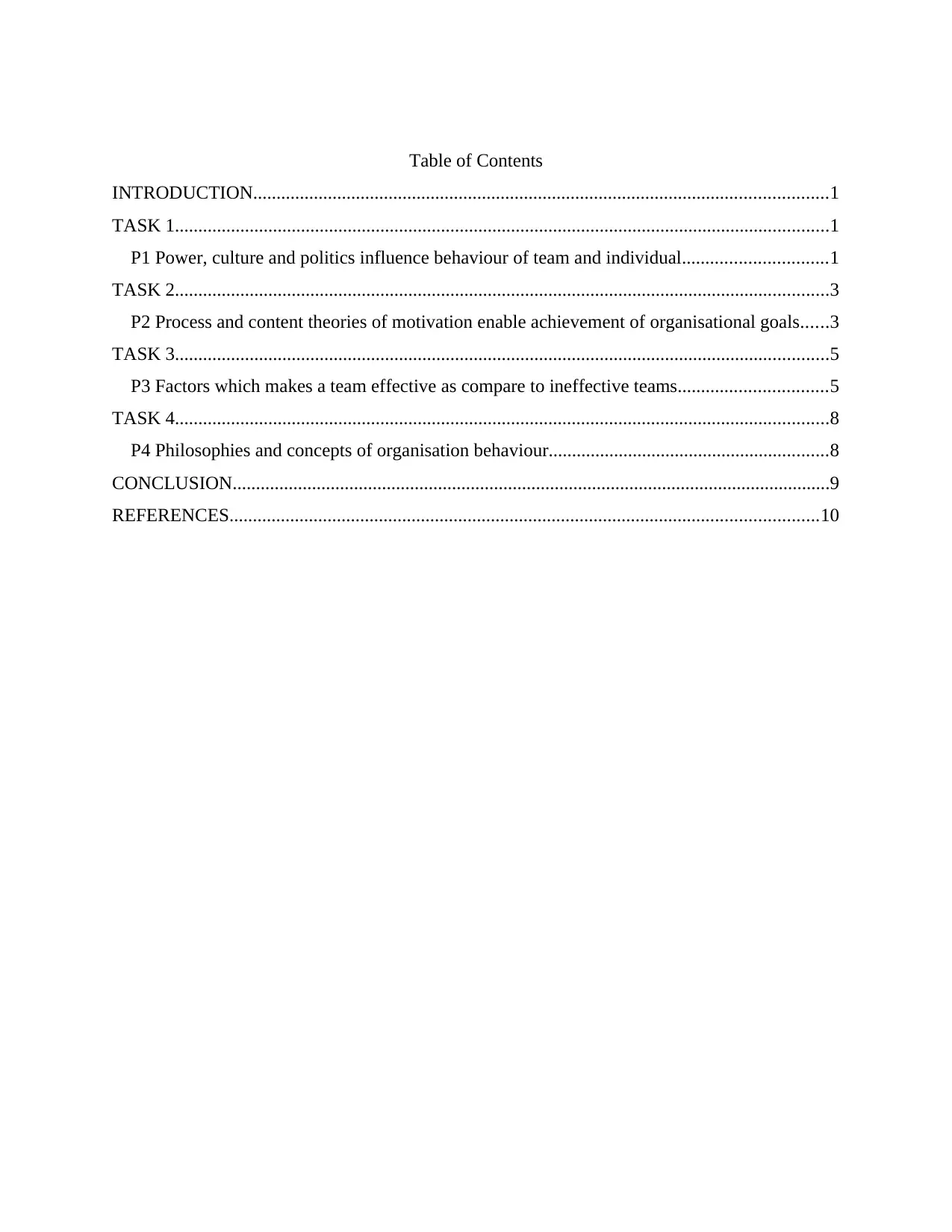
Table of Contents
INTRODUCTION...........................................................................................................................1
TASK 1............................................................................................................................................1
P1 Power, culture and politics influence behaviour of team and individual...............................1
TASK 2............................................................................................................................................3
P2 Process and content theories of motivation enable achievement of organisational goals......3
TASK 3............................................................................................................................................5
P3 Factors which makes a team effective as compare to ineffective teams................................5
TASK 4............................................................................................................................................8
P4 Philosophies and concepts of organisation behaviour............................................................8
CONCLUSION................................................................................................................................9
REFERENCES..............................................................................................................................10
INTRODUCTION...........................................................................................................................1
TASK 1............................................................................................................................................1
P1 Power, culture and politics influence behaviour of team and individual...............................1
TASK 2............................................................................................................................................3
P2 Process and content theories of motivation enable achievement of organisational goals......3
TASK 3............................................................................................................................................5
P3 Factors which makes a team effective as compare to ineffective teams................................5
TASK 4............................................................................................................................................8
P4 Philosophies and concepts of organisation behaviour............................................................8
CONCLUSION................................................................................................................................9
REFERENCES..............................................................................................................................10
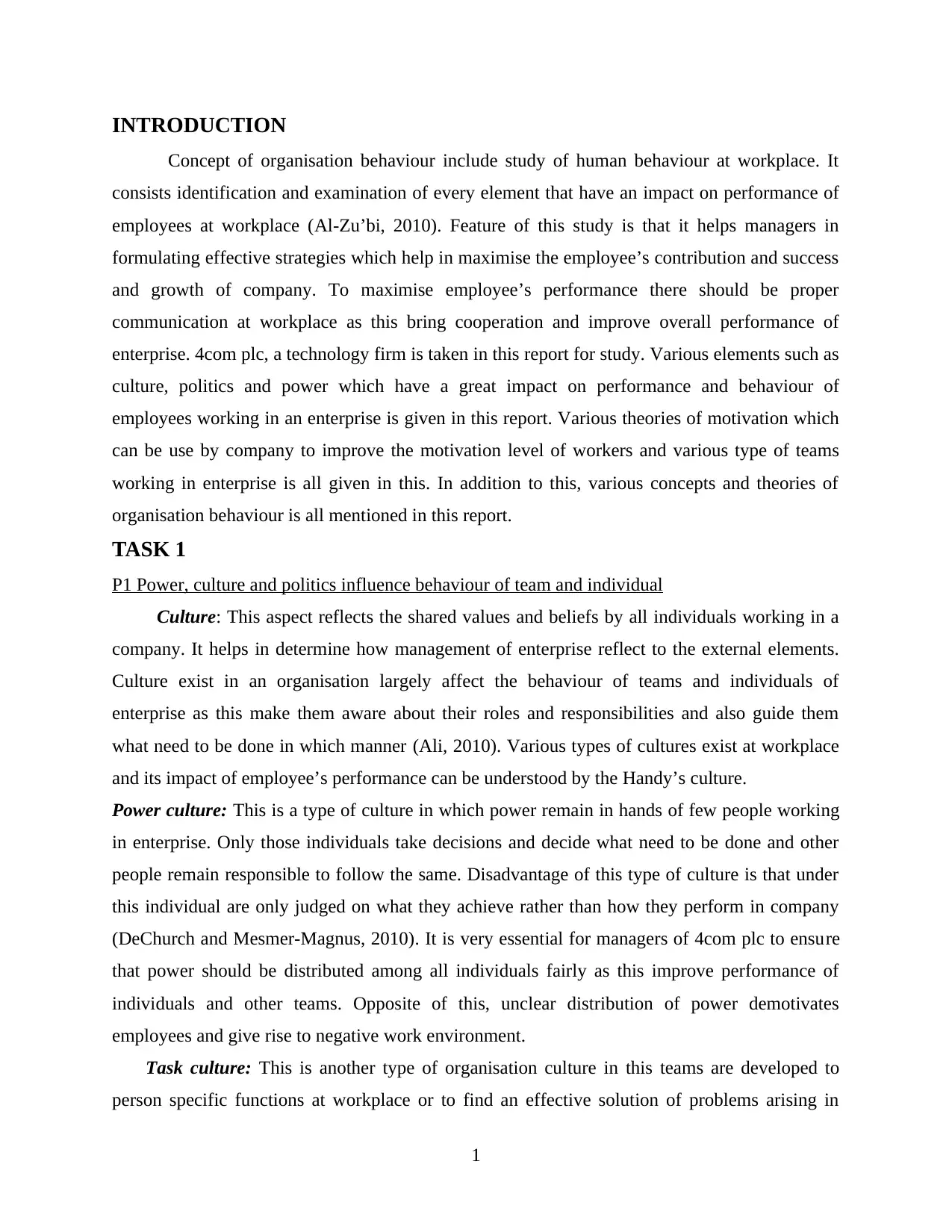
INTRODUCTION
Concept of organisation behaviour include study of human behaviour at workplace. It
consists identification and examination of every element that have an impact on performance of
employees at workplace (Al-Zu’bi, 2010). Feature of this study is that it helps managers in
formulating effective strategies which help in maximise the employee’s contribution and success
and growth of company. To maximise employee’s performance there should be proper
communication at workplace as this bring cooperation and improve overall performance of
enterprise. 4com plc, a technology firm is taken in this report for study. Various elements such as
culture, politics and power which have a great impact on performance and behaviour of
employees working in an enterprise is given in this report. Various theories of motivation which
can be use by company to improve the motivation level of workers and various type of teams
working in enterprise is all given in this. In addition to this, various concepts and theories of
organisation behaviour is all mentioned in this report.
TASK 1
P1 Power, culture and politics influence behaviour of team and individual
Culture: This aspect reflects the shared values and beliefs by all individuals working in a
company. It helps in determine how management of enterprise reflect to the external elements.
Culture exist in an organisation largely affect the behaviour of teams and individuals of
enterprise as this make them aware about their roles and responsibilities and also guide them
what need to be done in which manner (Ali, 2010). Various types of cultures exist at workplace
and its impact of employee’s performance can be understood by the Handy’s culture.
Power culture: This is a type of culture in which power remain in hands of few people working
in enterprise. Only those individuals take decisions and decide what need to be done and other
people remain responsible to follow the same. Disadvantage of this type of culture is that under
this individual are only judged on what they achieve rather than how they perform in company
(DeChurch and Mesmer-Magnus, 2010). It is very essential for managers of 4com plc to ensure
that power should be distributed among all individuals fairly as this improve performance of
individuals and other teams. Opposite of this, unclear distribution of power demotivates
employees and give rise to negative work environment.
Task culture: This is another type of organisation culture in this teams are developed to
person specific functions at workplace or to find an effective solution of problems arising in
1
Concept of organisation behaviour include study of human behaviour at workplace. It
consists identification and examination of every element that have an impact on performance of
employees at workplace (Al-Zu’bi, 2010). Feature of this study is that it helps managers in
formulating effective strategies which help in maximise the employee’s contribution and success
and growth of company. To maximise employee’s performance there should be proper
communication at workplace as this bring cooperation and improve overall performance of
enterprise. 4com plc, a technology firm is taken in this report for study. Various elements such as
culture, politics and power which have a great impact on performance and behaviour of
employees working in an enterprise is given in this report. Various theories of motivation which
can be use by company to improve the motivation level of workers and various type of teams
working in enterprise is all given in this. In addition to this, various concepts and theories of
organisation behaviour is all mentioned in this report.
TASK 1
P1 Power, culture and politics influence behaviour of team and individual
Culture: This aspect reflects the shared values and beliefs by all individuals working in a
company. It helps in determine how management of enterprise reflect to the external elements.
Culture exist in an organisation largely affect the behaviour of teams and individuals of
enterprise as this make them aware about their roles and responsibilities and also guide them
what need to be done in which manner (Ali, 2010). Various types of cultures exist at workplace
and its impact of employee’s performance can be understood by the Handy’s culture.
Power culture: This is a type of culture in which power remain in hands of few people working
in enterprise. Only those individuals take decisions and decide what need to be done and other
people remain responsible to follow the same. Disadvantage of this type of culture is that under
this individual are only judged on what they achieve rather than how they perform in company
(DeChurch and Mesmer-Magnus, 2010). It is very essential for managers of 4com plc to ensure
that power should be distributed among all individuals fairly as this improve performance of
individuals and other teams. Opposite of this, unclear distribution of power demotivates
employees and give rise to negative work environment.
Task culture: This is another type of organisation culture in this teams are developed to
person specific functions at workplace or to find an effective solution of problems arising in
1
⊘ This is a preview!⊘
Do you want full access?
Subscribe today to unlock all pages.

Trusted by 1+ million students worldwide
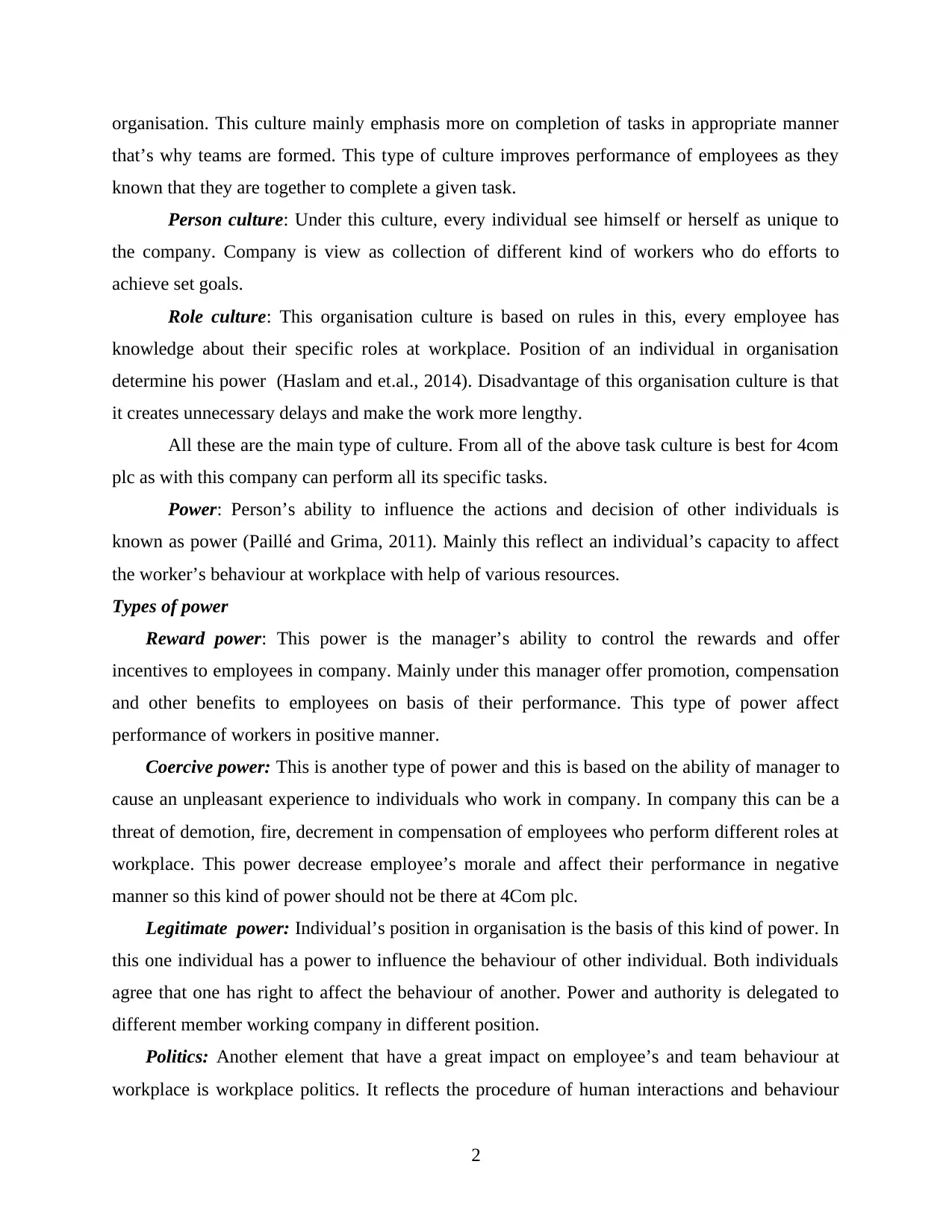
organisation. This culture mainly emphasis more on completion of tasks in appropriate manner
that’s why teams are formed. This type of culture improves performance of employees as they
known that they are together to complete a given task.
Person culture: Under this culture, every individual see himself or herself as unique to
the company. Company is view as collection of different kind of workers who do efforts to
achieve set goals.
Role culture: This organisation culture is based on rules in this, every employee has
knowledge about their specific roles at workplace. Position of an individual in organisation
determine his power (Haslam and et.al., 2014). Disadvantage of this organisation culture is that
it creates unnecessary delays and make the work more lengthy.
All these are the main type of culture. From all of the above task culture is best for 4com
plc as with this company can perform all its specific tasks.
Power: Person’s ability to influence the actions and decision of other individuals is
known as power (Paillé and Grima, 2011). Mainly this reflect an individual’s capacity to affect
the worker’s behaviour at workplace with help of various resources.
Types of power
Reward power: This power is the manager’s ability to control the rewards and offer
incentives to employees in company. Mainly under this manager offer promotion, compensation
and other benefits to employees on basis of their performance. This type of power affect
performance of workers in positive manner.
Coercive power: This is another type of power and this is based on the ability of manager to
cause an unpleasant experience to individuals who work in company. In company this can be a
threat of demotion, fire, decrement in compensation of employees who perform different roles at
workplace. This power decrease employee’s morale and affect their performance in negative
manner so this kind of power should not be there at 4Com plc.
Legitimate power: Individual’s position in organisation is the basis of this kind of power. In
this one individual has a power to influence the behaviour of other individual. Both individuals
agree that one has right to affect the behaviour of another. Power and authority is delegated to
different member working company in different position.
Politics: Another element that have a great impact on employee’s and team behaviour at
workplace is workplace politics. It reflects the procedure of human interactions and behaviour
2
that’s why teams are formed. This type of culture improves performance of employees as they
known that they are together to complete a given task.
Person culture: Under this culture, every individual see himself or herself as unique to
the company. Company is view as collection of different kind of workers who do efforts to
achieve set goals.
Role culture: This organisation culture is based on rules in this, every employee has
knowledge about their specific roles at workplace. Position of an individual in organisation
determine his power (Haslam and et.al., 2014). Disadvantage of this organisation culture is that
it creates unnecessary delays and make the work more lengthy.
All these are the main type of culture. From all of the above task culture is best for 4com
plc as with this company can perform all its specific tasks.
Power: Person’s ability to influence the actions and decision of other individuals is
known as power (Paillé and Grima, 2011). Mainly this reflect an individual’s capacity to affect
the worker’s behaviour at workplace with help of various resources.
Types of power
Reward power: This power is the manager’s ability to control the rewards and offer
incentives to employees in company. Mainly under this manager offer promotion, compensation
and other benefits to employees on basis of their performance. This type of power affect
performance of workers in positive manner.
Coercive power: This is another type of power and this is based on the ability of manager to
cause an unpleasant experience to individuals who work in company. In company this can be a
threat of demotion, fire, decrement in compensation of employees who perform different roles at
workplace. This power decrease employee’s morale and affect their performance in negative
manner so this kind of power should not be there at 4Com plc.
Legitimate power: Individual’s position in organisation is the basis of this kind of power. In
this one individual has a power to influence the behaviour of other individual. Both individuals
agree that one has right to affect the behaviour of another. Power and authority is delegated to
different member working company in different position.
Politics: Another element that have a great impact on employee’s and team behaviour at
workplace is workplace politics. It reflects the procedure of human interactions and behaviour
2
Paraphrase This Document
Need a fresh take? Get an instant paraphrase of this document with our AI Paraphraser

which also involve power and authority. Individual who believe in politics use their power to
influence the behaviour of other in a manner which offer them more benefits (Hershcovis,
2011). Positive politics or when individuals use their relations and power in benefit of company
then it improves the overall performance of company and vice versa so there should be positive
politics at 4Com plc so performance of individuals can be improve.
TASK 2
P2 Process and content theories of motivation enable achievement of organisational goals
Motivation is known as those external and internal elements that influence the behaviour of
an individual. Motivation is further divided into following two categories:
Intrinsic motivation: When performance or behaviour of an individual gets affected by
some internal elements then it is known as intrinsic motivation. Individual perform or behave in
a specific manner because it provides satisfaction to him.
Extrinsic motivation: Change in the performance of individuals due to some external forces
is known as extrinsic motivation.
Employees play an important role in every organisation. So it is very important that workers
should be enough motivated to perform a specific job at workplace (Owings and Kaplan, 2012).
Managers remain responsible to formulate strategies to enhance the motivation level of
employees. To encourage employees to work well various theories and concept of motivation are
there which can be use by the managers of 4Com plc. These motivation theories can be
understood by the following points:
Content theory of motivation
Maslow theory of motivation: Maslow provide a theory of motivation in which he
emphasis more on psychological needs of individuals or on the needs which require to be fulfil to
ensure proper functioning of workers (Ayyagari, Grover and Purvis, 2011). This theory is
divided into five levels in which fulfilment of one level give rise to the next level which
influence the behaviour of an individual. Five level of this motivation theory can be understood
by the points given below:
Physiological needs: It is the first level of motivation theory given by Maslow. This
covers the basic requirements which are essential for human survival and this includes
clothes, food, shelter, air, water, sleep and warmth. To ensure optimal functioning of a
human, fulfilment of all these needs is very necessary. These needs are considered as
3
influence the behaviour of other in a manner which offer them more benefits (Hershcovis,
2011). Positive politics or when individuals use their relations and power in benefit of company
then it improves the overall performance of company and vice versa so there should be positive
politics at 4Com plc so performance of individuals can be improve.
TASK 2
P2 Process and content theories of motivation enable achievement of organisational goals
Motivation is known as those external and internal elements that influence the behaviour of
an individual. Motivation is further divided into following two categories:
Intrinsic motivation: When performance or behaviour of an individual gets affected by
some internal elements then it is known as intrinsic motivation. Individual perform or behave in
a specific manner because it provides satisfaction to him.
Extrinsic motivation: Change in the performance of individuals due to some external forces
is known as extrinsic motivation.
Employees play an important role in every organisation. So it is very important that workers
should be enough motivated to perform a specific job at workplace (Owings and Kaplan, 2012).
Managers remain responsible to formulate strategies to enhance the motivation level of
employees. To encourage employees to work well various theories and concept of motivation are
there which can be use by the managers of 4Com plc. These motivation theories can be
understood by the following points:
Content theory of motivation
Maslow theory of motivation: Maslow provide a theory of motivation in which he
emphasis more on psychological needs of individuals or on the needs which require to be fulfil to
ensure proper functioning of workers (Ayyagari, Grover and Purvis, 2011). This theory is
divided into five levels in which fulfilment of one level give rise to the next level which
influence the behaviour of an individual. Five level of this motivation theory can be understood
by the points given below:
Physiological needs: It is the first level of motivation theory given by Maslow. This
covers the basic requirements which are essential for human survival and this includes
clothes, food, shelter, air, water, sleep and warmth. To ensure optimal functioning of a
human, fulfilment of all these needs is very necessary. These needs are considered as
3
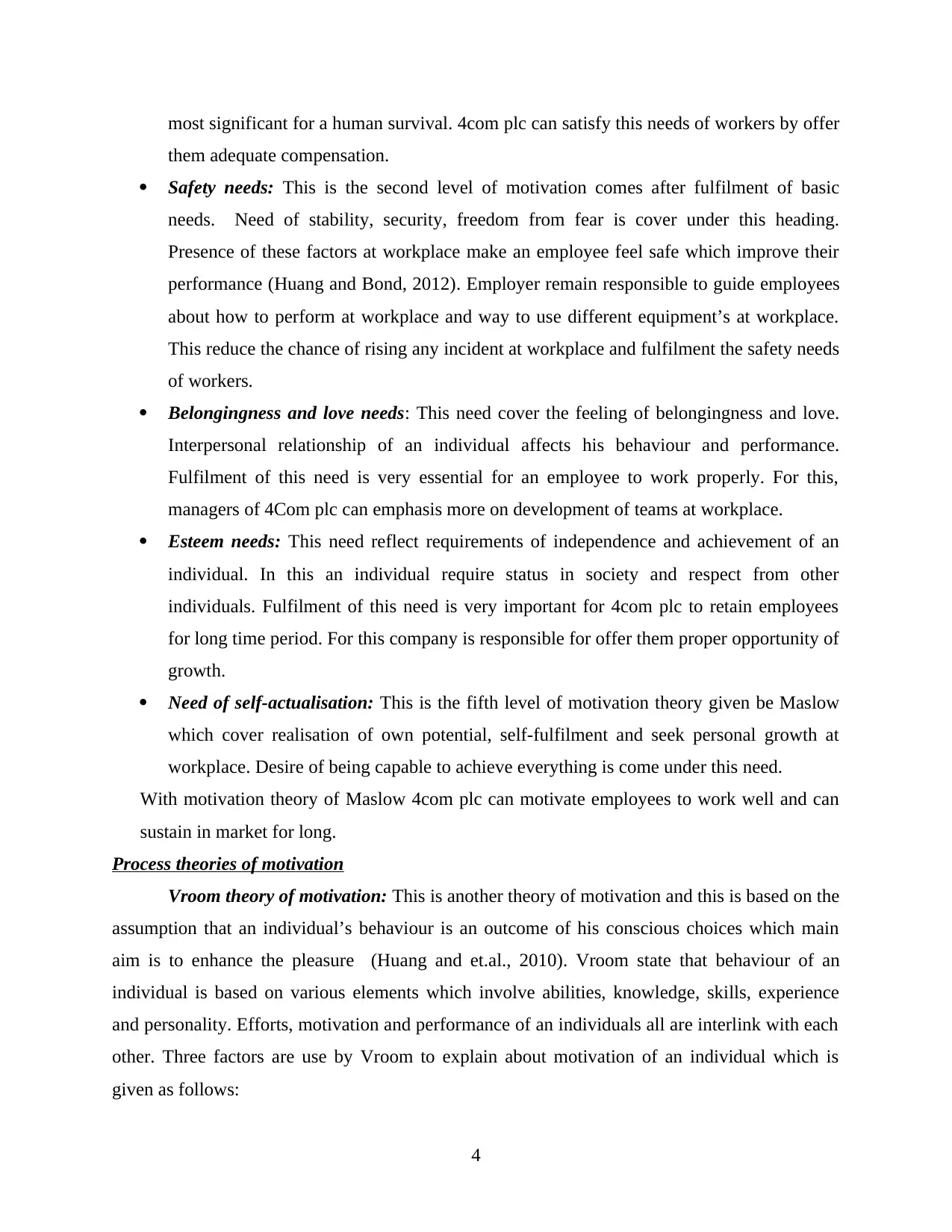
most significant for a human survival. 4com plc can satisfy this needs of workers by offer
them adequate compensation.
Safety needs: This is the second level of motivation comes after fulfilment of basic
needs. Need of stability, security, freedom from fear is cover under this heading.
Presence of these factors at workplace make an employee feel safe which improve their
performance (Huang and Bond, 2012). Employer remain responsible to guide employees
about how to perform at workplace and way to use different equipment’s at workplace.
This reduce the chance of rising any incident at workplace and fulfilment the safety needs
of workers.
Belongingness and love needs: This need cover the feeling of belongingness and love.
Interpersonal relationship of an individual affects his behaviour and performance.
Fulfilment of this need is very essential for an employee to work properly. For this,
managers of 4Com plc can emphasis more on development of teams at workplace.
Esteem needs: This need reflect requirements of independence and achievement of an
individual. In this an individual require status in society and respect from other
individuals. Fulfilment of this need is very important for 4com plc to retain employees
for long time period. For this company is responsible for offer them proper opportunity of
growth.
Need of self-actualisation: This is the fifth level of motivation theory given be Maslow
which cover realisation of own potential, self-fulfilment and seek personal growth at
workplace. Desire of being capable to achieve everything is come under this need.
With motivation theory of Maslow 4com plc can motivate employees to work well and can
sustain in market for long.
Process theories of motivation
Vroom theory of motivation: This is another theory of motivation and this is based on the
assumption that an individual’s behaviour is an outcome of his conscious choices which main
aim is to enhance the pleasure (Huang and et.al., 2010). Vroom state that behaviour of an
individual is based on various elements which involve abilities, knowledge, skills, experience
and personality. Efforts, motivation and performance of an individuals all are interlink with each
other. Three factors are use by Vroom to explain about motivation of an individual which is
given as follows:
4
them adequate compensation.
Safety needs: This is the second level of motivation comes after fulfilment of basic
needs. Need of stability, security, freedom from fear is cover under this heading.
Presence of these factors at workplace make an employee feel safe which improve their
performance (Huang and Bond, 2012). Employer remain responsible to guide employees
about how to perform at workplace and way to use different equipment’s at workplace.
This reduce the chance of rising any incident at workplace and fulfilment the safety needs
of workers.
Belongingness and love needs: This need cover the feeling of belongingness and love.
Interpersonal relationship of an individual affects his behaviour and performance.
Fulfilment of this need is very essential for an employee to work properly. For this,
managers of 4Com plc can emphasis more on development of teams at workplace.
Esteem needs: This need reflect requirements of independence and achievement of an
individual. In this an individual require status in society and respect from other
individuals. Fulfilment of this need is very important for 4com plc to retain employees
for long time period. For this company is responsible for offer them proper opportunity of
growth.
Need of self-actualisation: This is the fifth level of motivation theory given be Maslow
which cover realisation of own potential, self-fulfilment and seek personal growth at
workplace. Desire of being capable to achieve everything is come under this need.
With motivation theory of Maslow 4com plc can motivate employees to work well and can
sustain in market for long.
Process theories of motivation
Vroom theory of motivation: This is another theory of motivation and this is based on the
assumption that an individual’s behaviour is an outcome of his conscious choices which main
aim is to enhance the pleasure (Huang and et.al., 2010). Vroom state that behaviour of an
individual is based on various elements which involve abilities, knowledge, skills, experience
and personality. Efforts, motivation and performance of an individuals all are interlink with each
other. Three factors are use by Vroom to explain about motivation of an individual which is
given as follows:
4
⊘ This is a preview!⊘
Do you want full access?
Subscribe today to unlock all pages.

Trusted by 1+ million students worldwide
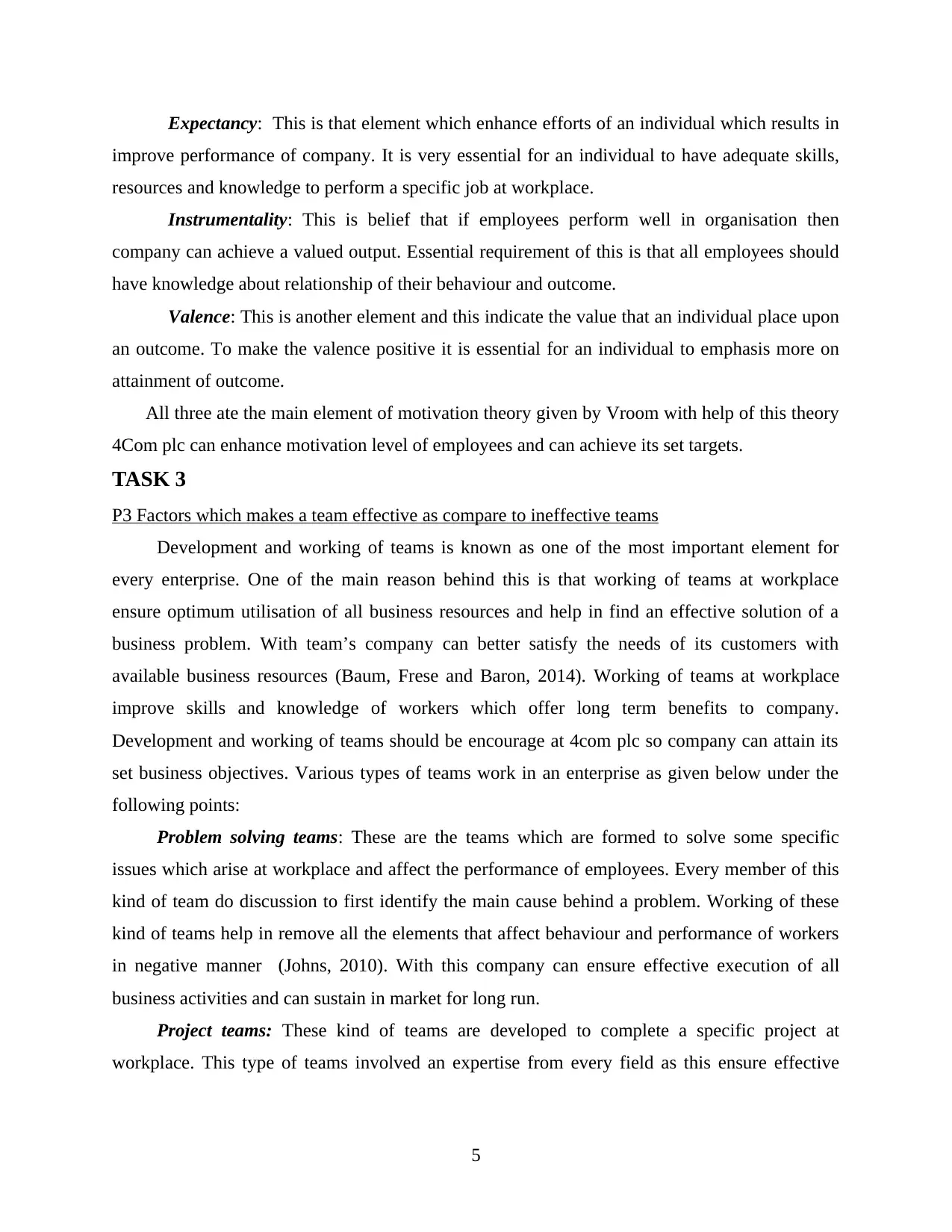
Expectancy: This is that element which enhance efforts of an individual which results in
improve performance of company. It is very essential for an individual to have adequate skills,
resources and knowledge to perform a specific job at workplace.
Instrumentality: This is belief that if employees perform well in organisation then
company can achieve a valued output. Essential requirement of this is that all employees should
have knowledge about relationship of their behaviour and outcome.
Valence: This is another element and this indicate the value that an individual place upon
an outcome. To make the valence positive it is essential for an individual to emphasis more on
attainment of outcome.
All three ate the main element of motivation theory given by Vroom with help of this theory
4Com plc can enhance motivation level of employees and can achieve its set targets.
TASK 3
P3 Factors which makes a team effective as compare to ineffective teams
Development and working of teams is known as one of the most important element for
every enterprise. One of the main reason behind this is that working of teams at workplace
ensure optimum utilisation of all business resources and help in find an effective solution of a
business problem. With team’s company can better satisfy the needs of its customers with
available business resources (Baum, Frese and Baron, 2014). Working of teams at workplace
improve skills and knowledge of workers which offer long term benefits to company.
Development and working of teams should be encourage at 4com plc so company can attain its
set business objectives. Various types of teams work in an enterprise as given below under the
following points:
Problem solving teams: These are the teams which are formed to solve some specific
issues which arise at workplace and affect the performance of employees. Every member of this
kind of team do discussion to first identify the main cause behind a problem. Working of these
kind of teams help in remove all the elements that affect behaviour and performance of workers
in negative manner (Johns, 2010). With this company can ensure effective execution of all
business activities and can sustain in market for long run.
Project teams: These kind of teams are developed to complete a specific project at
workplace. This type of teams involved an expertise from every field as this ensure effective
5
improve performance of company. It is very essential for an individual to have adequate skills,
resources and knowledge to perform a specific job at workplace.
Instrumentality: This is belief that if employees perform well in organisation then
company can achieve a valued output. Essential requirement of this is that all employees should
have knowledge about relationship of their behaviour and outcome.
Valence: This is another element and this indicate the value that an individual place upon
an outcome. To make the valence positive it is essential for an individual to emphasis more on
attainment of outcome.
All three ate the main element of motivation theory given by Vroom with help of this theory
4Com plc can enhance motivation level of employees and can achieve its set targets.
TASK 3
P3 Factors which makes a team effective as compare to ineffective teams
Development and working of teams is known as one of the most important element for
every enterprise. One of the main reason behind this is that working of teams at workplace
ensure optimum utilisation of all business resources and help in find an effective solution of a
business problem. With team’s company can better satisfy the needs of its customers with
available business resources (Baum, Frese and Baron, 2014). Working of teams at workplace
improve skills and knowledge of workers which offer long term benefits to company.
Development and working of teams should be encourage at 4com plc so company can attain its
set business objectives. Various types of teams work in an enterprise as given below under the
following points:
Problem solving teams: These are the teams which are formed to solve some specific
issues which arise at workplace and affect the performance of employees. Every member of this
kind of team do discussion to first identify the main cause behind a problem. Working of these
kind of teams help in remove all the elements that affect behaviour and performance of workers
in negative manner (Johns, 2010). With this company can ensure effective execution of all
business activities and can sustain in market for long run.
Project teams: These kind of teams are developed to complete a specific project at
workplace. This type of teams involved an expertise from every field as this ensure effective
5
Paraphrase This Document
Need a fresh take? Get an instant paraphrase of this document with our AI Paraphraser
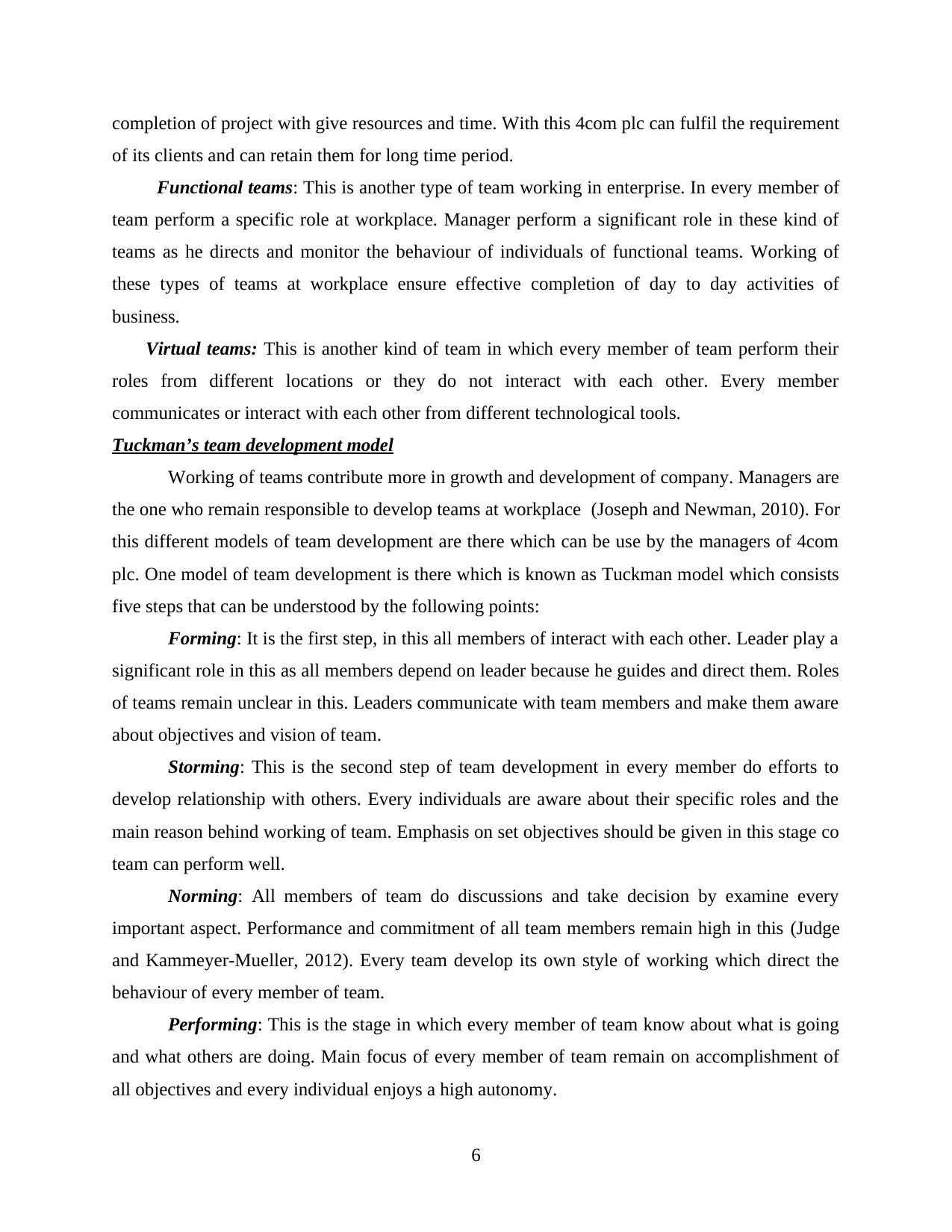
completion of project with give resources and time. With this 4com plc can fulfil the requirement
of its clients and can retain them for long time period.
Functional teams: This is another type of team working in enterprise. In every member of
team perform a specific role at workplace. Manager perform a significant role in these kind of
teams as he directs and monitor the behaviour of individuals of functional teams. Working of
these types of teams at workplace ensure effective completion of day to day activities of
business.
Virtual teams: This is another kind of team in which every member of team perform their
roles from different locations or they do not interact with each other. Every member
communicates or interact with each other from different technological tools.
Tuckman’s team development model
Working of teams contribute more in growth and development of company. Managers are
the one who remain responsible to develop teams at workplace (Joseph and Newman, 2010). For
this different models of team development are there which can be use by the managers of 4com
plc. One model of team development is there which is known as Tuckman model which consists
five steps that can be understood by the following points:
Forming: It is the first step, in this all members of interact with each other. Leader play a
significant role in this as all members depend on leader because he guides and direct them. Roles
of teams remain unclear in this. Leaders communicate with team members and make them aware
about objectives and vision of team.
Storming: This is the second step of team development in every member do efforts to
develop relationship with others. Every individuals are aware about their specific roles and the
main reason behind working of team. Emphasis on set objectives should be given in this stage co
team can perform well.
Norming: All members of team do discussions and take decision by examine every
important aspect. Performance and commitment of all team members remain high in this (Judge
and Kammeyer‐Mueller, 2012). Every team develop its own style of working which direct the
behaviour of every member of team.
Performing: This is the stage in which every member of team know about what is going
and what others are doing. Main focus of every member of team remain on accomplishment of
all objectives and every individual enjoys a high autonomy.
6
of its clients and can retain them for long time period.
Functional teams: This is another type of team working in enterprise. In every member of
team perform a specific role at workplace. Manager perform a significant role in these kind of
teams as he directs and monitor the behaviour of individuals of functional teams. Working of
these types of teams at workplace ensure effective completion of day to day activities of
business.
Virtual teams: This is another kind of team in which every member of team perform their
roles from different locations or they do not interact with each other. Every member
communicates or interact with each other from different technological tools.
Tuckman’s team development model
Working of teams contribute more in growth and development of company. Managers are
the one who remain responsible to develop teams at workplace (Joseph and Newman, 2010). For
this different models of team development are there which can be use by the managers of 4com
plc. One model of team development is there which is known as Tuckman model which consists
five steps that can be understood by the following points:
Forming: It is the first step, in this all members of interact with each other. Leader play a
significant role in this as all members depend on leader because he guides and direct them. Roles
of teams remain unclear in this. Leaders communicate with team members and make them aware
about objectives and vision of team.
Storming: This is the second step of team development in every member do efforts to
develop relationship with others. Every individuals are aware about their specific roles and the
main reason behind working of team. Emphasis on set objectives should be given in this stage co
team can perform well.
Norming: All members of team do discussions and take decision by examine every
important aspect. Performance and commitment of all team members remain high in this (Judge
and Kammeyer‐Mueller, 2012). Every team develop its own style of working which direct the
behaviour of every member of team.
Performing: This is the stage in which every member of team know about what is going
and what others are doing. Main focus of every member of team remain on accomplishment of
all objectives and every individual enjoys a high autonomy.
6
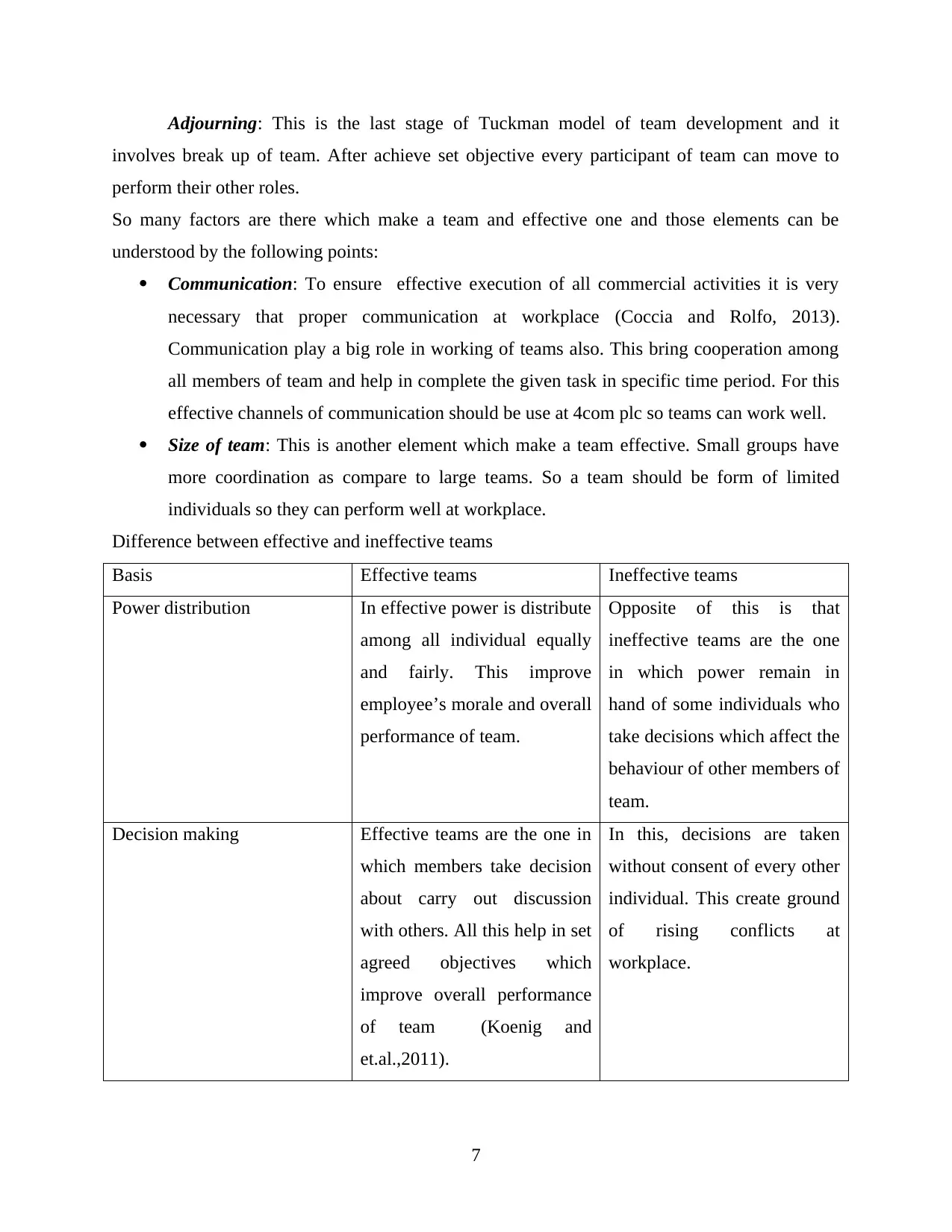
Adjourning: This is the last stage of Tuckman model of team development and it
involves break up of team. After achieve set objective every participant of team can move to
perform their other roles.
So many factors are there which make a team and effective one and those elements can be
understood by the following points:
Communication: To ensure effective execution of all commercial activities it is very
necessary that proper communication at workplace (Coccia and Rolfo, 2013).
Communication play a big role in working of teams also. This bring cooperation among
all members of team and help in complete the given task in specific time period. For this
effective channels of communication should be use at 4com plc so teams can work well.
Size of team: This is another element which make a team effective. Small groups have
more coordination as compare to large teams. So a team should be form of limited
individuals so they can perform well at workplace.
Difference between effective and ineffective teams
Basis Effective teams Ineffective teams
Power distribution In effective power is distribute
among all individual equally
and fairly. This improve
employee’s morale and overall
performance of team.
Opposite of this is that
ineffective teams are the one
in which power remain in
hand of some individuals who
take decisions which affect the
behaviour of other members of
team.
Decision making Effective teams are the one in
which members take decision
about carry out discussion
with others. All this help in set
agreed objectives which
improve overall performance
of team (Koenig and
et.al.,2011).
In this, decisions are taken
without consent of every other
individual. This create ground
of rising conflicts at
workplace.
7
involves break up of team. After achieve set objective every participant of team can move to
perform their other roles.
So many factors are there which make a team and effective one and those elements can be
understood by the following points:
Communication: To ensure effective execution of all commercial activities it is very
necessary that proper communication at workplace (Coccia and Rolfo, 2013).
Communication play a big role in working of teams also. This bring cooperation among
all members of team and help in complete the given task in specific time period. For this
effective channels of communication should be use at 4com plc so teams can work well.
Size of team: This is another element which make a team effective. Small groups have
more coordination as compare to large teams. So a team should be form of limited
individuals so they can perform well at workplace.
Difference between effective and ineffective teams
Basis Effective teams Ineffective teams
Power distribution In effective power is distribute
among all individual equally
and fairly. This improve
employee’s morale and overall
performance of team.
Opposite of this is that
ineffective teams are the one
in which power remain in
hand of some individuals who
take decisions which affect the
behaviour of other members of
team.
Decision making Effective teams are the one in
which members take decision
about carry out discussion
with others. All this help in set
agreed objectives which
improve overall performance
of team (Koenig and
et.al.,2011).
In this, decisions are taken
without consent of every other
individual. This create ground
of rising conflicts at
workplace.
7
⊘ This is a preview!⊘
Do you want full access?
Subscribe today to unlock all pages.

Trusted by 1+ million students worldwide
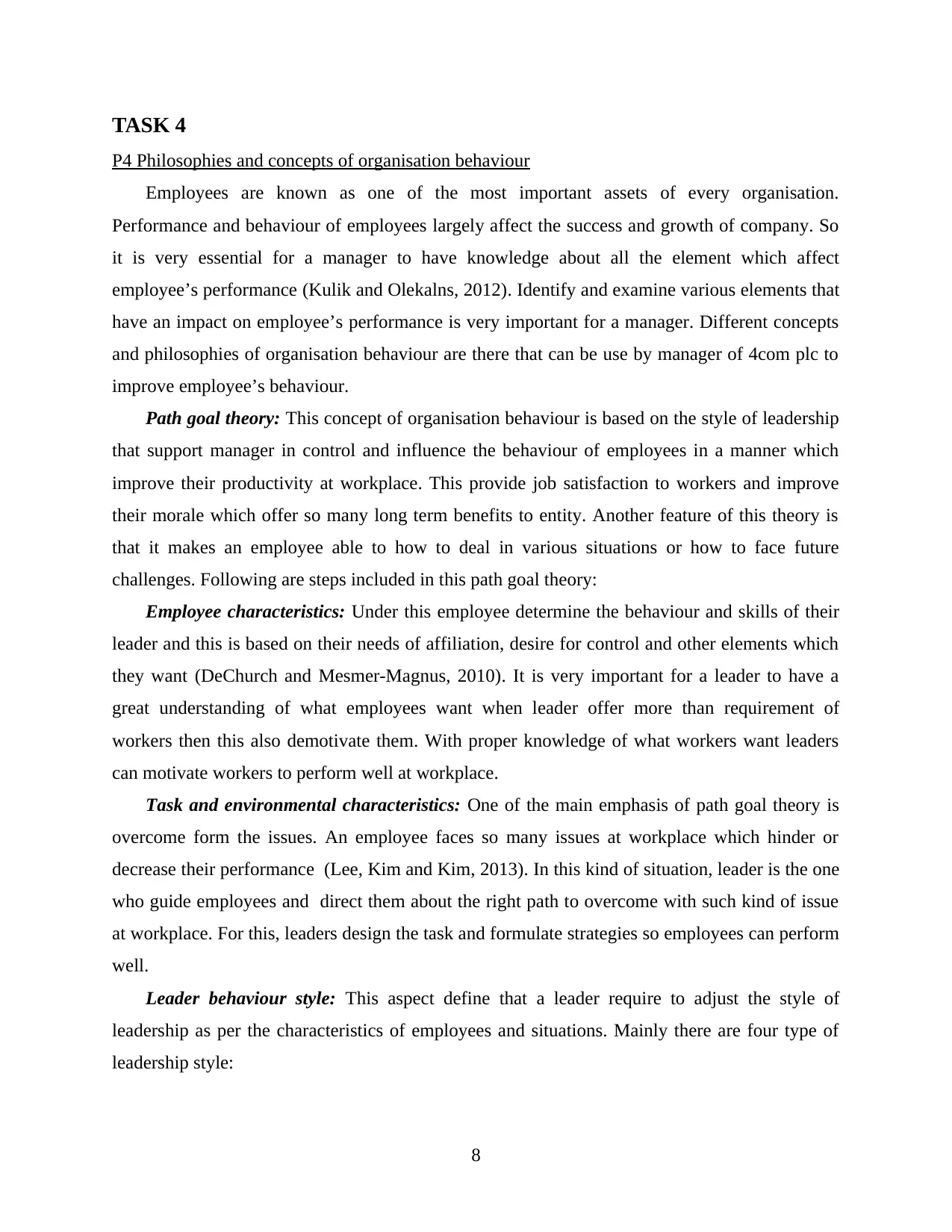
TASK 4
P4 Philosophies and concepts of organisation behaviour
Employees are known as one of the most important assets of every organisation.
Performance and behaviour of employees largely affect the success and growth of company. So
it is very essential for a manager to have knowledge about all the element which affect
employee’s performance (Kulik and Olekalns, 2012). Identify and examine various elements that
have an impact on employee’s performance is very important for a manager. Different concepts
and philosophies of organisation behaviour are there that can be use by manager of 4com plc to
improve employee’s behaviour.
Path goal theory: This concept of organisation behaviour is based on the style of leadership
that support manager in control and influence the behaviour of employees in a manner which
improve their productivity at workplace. This provide job satisfaction to workers and improve
their morale which offer so many long term benefits to entity. Another feature of this theory is
that it makes an employee able to how to deal in various situations or how to face future
challenges. Following are steps included in this path goal theory:
Employee characteristics: Under this employee determine the behaviour and skills of their
leader and this is based on their needs of affiliation, desire for control and other elements which
they want (DeChurch and Mesmer-Magnus, 2010). It is very important for a leader to have a
great understanding of what employees want when leader offer more than requirement of
workers then this also demotivate them. With proper knowledge of what workers want leaders
can motivate workers to perform well at workplace.
Task and environmental characteristics: One of the main emphasis of path goal theory is
overcome form the issues. An employee faces so many issues at workplace which hinder or
decrease their performance (Lee, Kim and Kim, 2013). In this kind of situation, leader is the one
who guide employees and direct them about the right path to overcome with such kind of issue
at workplace. For this, leaders design the task and formulate strategies so employees can perform
well.
Leader behaviour style: This aspect define that a leader require to adjust the style of
leadership as per the characteristics of employees and situations. Mainly there are four type of
leadership style:
8
P4 Philosophies and concepts of organisation behaviour
Employees are known as one of the most important assets of every organisation.
Performance and behaviour of employees largely affect the success and growth of company. So
it is very essential for a manager to have knowledge about all the element which affect
employee’s performance (Kulik and Olekalns, 2012). Identify and examine various elements that
have an impact on employee’s performance is very important for a manager. Different concepts
and philosophies of organisation behaviour are there that can be use by manager of 4com plc to
improve employee’s behaviour.
Path goal theory: This concept of organisation behaviour is based on the style of leadership
that support manager in control and influence the behaviour of employees in a manner which
improve their productivity at workplace. This provide job satisfaction to workers and improve
their morale which offer so many long term benefits to entity. Another feature of this theory is
that it makes an employee able to how to deal in various situations or how to face future
challenges. Following are steps included in this path goal theory:
Employee characteristics: Under this employee determine the behaviour and skills of their
leader and this is based on their needs of affiliation, desire for control and other elements which
they want (DeChurch and Mesmer-Magnus, 2010). It is very important for a leader to have a
great understanding of what employees want when leader offer more than requirement of
workers then this also demotivate them. With proper knowledge of what workers want leaders
can motivate workers to perform well at workplace.
Task and environmental characteristics: One of the main emphasis of path goal theory is
overcome form the issues. An employee faces so many issues at workplace which hinder or
decrease their performance (Lee, Kim and Kim, 2013). In this kind of situation, leader is the one
who guide employees and direct them about the right path to overcome with such kind of issue
at workplace. For this, leaders design the task and formulate strategies so employees can perform
well.
Leader behaviour style: This aspect define that a leader require to adjust the style of
leadership as per the characteristics of employees and situations. Mainly there are four type of
leadership style:
8
Paraphrase This Document
Need a fresh take? Get an instant paraphrase of this document with our AI Paraphraser
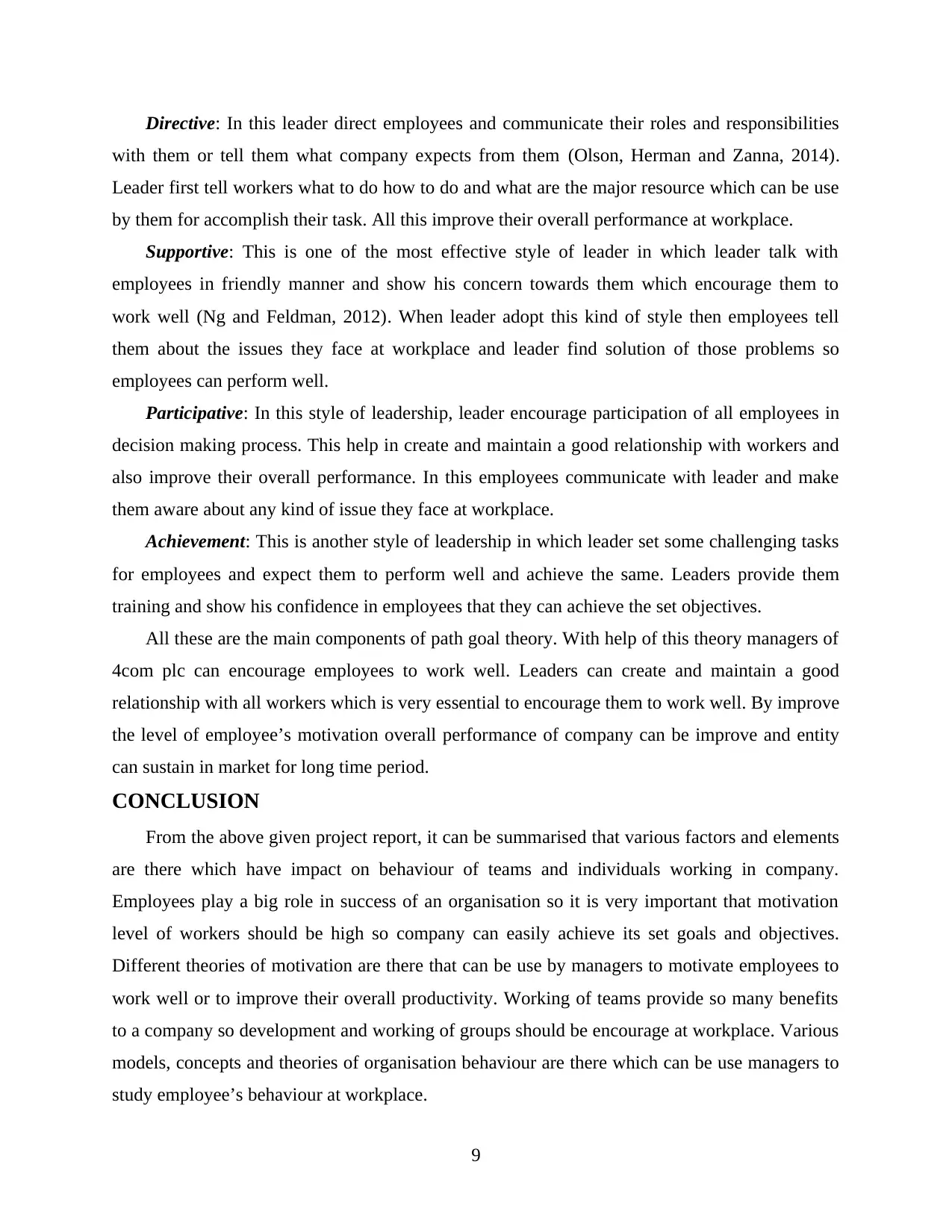
Directive: In this leader direct employees and communicate their roles and responsibilities
with them or tell them what company expects from them (Olson, Herman and Zanna, 2014).
Leader first tell workers what to do how to do and what are the major resource which can be use
by them for accomplish their task. All this improve their overall performance at workplace.
Supportive: This is one of the most effective style of leader in which leader talk with
employees in friendly manner and show his concern towards them which encourage them to
work well (Ng and Feldman, 2012). When leader adopt this kind of style then employees tell
them about the issues they face at workplace and leader find solution of those problems so
employees can perform well.
Participative: In this style of leadership, leader encourage participation of all employees in
decision making process. This help in create and maintain a good relationship with workers and
also improve their overall performance. In this employees communicate with leader and make
them aware about any kind of issue they face at workplace.
Achievement: This is another style of leadership in which leader set some challenging tasks
for employees and expect them to perform well and achieve the same. Leaders provide them
training and show his confidence in employees that they can achieve the set objectives.
All these are the main components of path goal theory. With help of this theory managers of
4com plc can encourage employees to work well. Leaders can create and maintain a good
relationship with all workers which is very essential to encourage them to work well. By improve
the level of employee’s motivation overall performance of company can be improve and entity
can sustain in market for long time period.
CONCLUSION
From the above given project report, it can be summarised that various factors and elements
are there which have impact on behaviour of teams and individuals working in company.
Employees play a big role in success of an organisation so it is very important that motivation
level of workers should be high so company can easily achieve its set goals and objectives.
Different theories of motivation are there that can be use by managers to motivate employees to
work well or to improve their overall productivity. Working of teams provide so many benefits
to a company so development and working of groups should be encourage at workplace. Various
models, concepts and theories of organisation behaviour are there which can be use managers to
study employee’s behaviour at workplace.
9
with them or tell them what company expects from them (Olson, Herman and Zanna, 2014).
Leader first tell workers what to do how to do and what are the major resource which can be use
by them for accomplish their task. All this improve their overall performance at workplace.
Supportive: This is one of the most effective style of leader in which leader talk with
employees in friendly manner and show his concern towards them which encourage them to
work well (Ng and Feldman, 2012). When leader adopt this kind of style then employees tell
them about the issues they face at workplace and leader find solution of those problems so
employees can perform well.
Participative: In this style of leadership, leader encourage participation of all employees in
decision making process. This help in create and maintain a good relationship with workers and
also improve their overall performance. In this employees communicate with leader and make
them aware about any kind of issue they face at workplace.
Achievement: This is another style of leadership in which leader set some challenging tasks
for employees and expect them to perform well and achieve the same. Leaders provide them
training and show his confidence in employees that they can achieve the set objectives.
All these are the main components of path goal theory. With help of this theory managers of
4com plc can encourage employees to work well. Leaders can create and maintain a good
relationship with all workers which is very essential to encourage them to work well. By improve
the level of employee’s motivation overall performance of company can be improve and entity
can sustain in market for long time period.
CONCLUSION
From the above given project report, it can be summarised that various factors and elements
are there which have impact on behaviour of teams and individuals working in company.
Employees play a big role in success of an organisation so it is very important that motivation
level of workers should be high so company can easily achieve its set goals and objectives.
Different theories of motivation are there that can be use by managers to motivate employees to
work well or to improve their overall productivity. Working of teams provide so many benefits
to a company so development and working of groups should be encourage at workplace. Various
models, concepts and theories of organisation behaviour are there which can be use managers to
study employee’s behaviour at workplace.
9
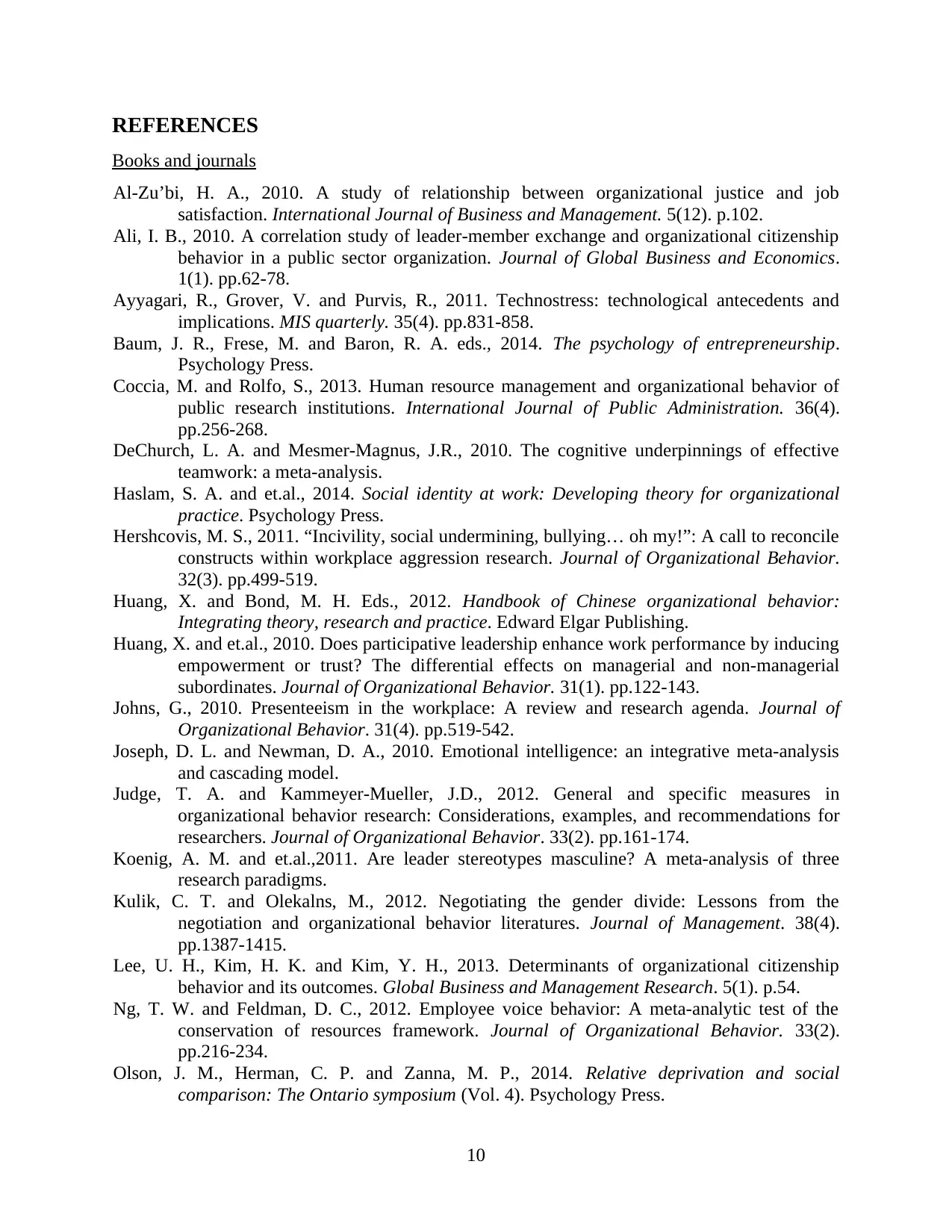
REFERENCES
Books and journals
Al-Zu’bi, H. A., 2010. A study of relationship between organizational justice and job
satisfaction. International Journal of Business and Management. 5(12). p.102.
Ali, I. B., 2010. A correlation study of leader-member exchange and organizational citizenship
behavior in a public sector organization. Journal of Global Business and Economics.
1(1). pp.62-78.
Ayyagari, R., Grover, V. and Purvis, R., 2011. Technostress: technological antecedents and
implications. MIS quarterly. 35(4). pp.831-858.
Baum, J. R., Frese, M. and Baron, R. A. eds., 2014. The psychology of entrepreneurship.
Psychology Press.
Coccia, M. and Rolfo, S., 2013. Human resource management and organizational behavior of
public research institutions. International Journal of Public Administration. 36(4).
pp.256-268.
DeChurch, L. A. and Mesmer-Magnus, J.R., 2010. The cognitive underpinnings of effective
teamwork: a meta-analysis.
Haslam, S. A. and et.al., 2014. Social identity at work: Developing theory for organizational
practice. Psychology Press.
Hershcovis, M. S., 2011. “Incivility, social undermining, bullying… oh my!”: A call to reconcile
constructs within workplace aggression research. Journal of Organizational Behavior.
32(3). pp.499-519.
Huang, X. and Bond, M. H. Eds., 2012. Handbook of Chinese organizational behavior:
Integrating theory, research and practice. Edward Elgar Publishing.
Huang, X. and et.al., 2010. Does participative leadership enhance work performance by inducing
empowerment or trust? The differential effects on managerial and non‐managerial
subordinates. Journal of Organizational Behavior. 31(1). pp.122-143.
Johns, G., 2010. Presenteeism in the workplace: A review and research agenda. Journal of
Organizational Behavior. 31(4). pp.519-542.
Joseph, D. L. and Newman, D. A., 2010. Emotional intelligence: an integrative meta-analysis
and cascading model.
Judge, T. A. and Kammeyer‐Mueller, J.D., 2012. General and specific measures in
organizational behavior research: Considerations, examples, and recommendations for
researchers. Journal of Organizational Behavior. 33(2). pp.161-174.
Koenig, A. M. and et.al.,2011. Are leader stereotypes masculine? A meta-analysis of three
research paradigms.
Kulik, C. T. and Olekalns, M., 2012. Negotiating the gender divide: Lessons from the
negotiation and organizational behavior literatures. Journal of Management. 38(4).
pp.1387-1415.
Lee, U. H., Kim, H. K. and Kim, Y. H., 2013. Determinants of organizational citizenship
behavior and its outcomes. Global Business and Management Research. 5(1). p.54.
Ng, T. W. and Feldman, D. C., 2012. Employee voice behavior: A meta‐analytic test of the
conservation of resources framework. Journal of Organizational Behavior. 33(2).
pp.216-234.
Olson, J. M., Herman, C. P. and Zanna, M. P., 2014. Relative deprivation and social
comparison: The Ontario symposium (Vol. 4). Psychology Press.
10
Books and journals
Al-Zu’bi, H. A., 2010. A study of relationship between organizational justice and job
satisfaction. International Journal of Business and Management. 5(12). p.102.
Ali, I. B., 2010. A correlation study of leader-member exchange and organizational citizenship
behavior in a public sector organization. Journal of Global Business and Economics.
1(1). pp.62-78.
Ayyagari, R., Grover, V. and Purvis, R., 2011. Technostress: technological antecedents and
implications. MIS quarterly. 35(4). pp.831-858.
Baum, J. R., Frese, M. and Baron, R. A. eds., 2014. The psychology of entrepreneurship.
Psychology Press.
Coccia, M. and Rolfo, S., 2013. Human resource management and organizational behavior of
public research institutions. International Journal of Public Administration. 36(4).
pp.256-268.
DeChurch, L. A. and Mesmer-Magnus, J.R., 2010. The cognitive underpinnings of effective
teamwork: a meta-analysis.
Haslam, S. A. and et.al., 2014. Social identity at work: Developing theory for organizational
practice. Psychology Press.
Hershcovis, M. S., 2011. “Incivility, social undermining, bullying… oh my!”: A call to reconcile
constructs within workplace aggression research. Journal of Organizational Behavior.
32(3). pp.499-519.
Huang, X. and Bond, M. H. Eds., 2012. Handbook of Chinese organizational behavior:
Integrating theory, research and practice. Edward Elgar Publishing.
Huang, X. and et.al., 2010. Does participative leadership enhance work performance by inducing
empowerment or trust? The differential effects on managerial and non‐managerial
subordinates. Journal of Organizational Behavior. 31(1). pp.122-143.
Johns, G., 2010. Presenteeism in the workplace: A review and research agenda. Journal of
Organizational Behavior. 31(4). pp.519-542.
Joseph, D. L. and Newman, D. A., 2010. Emotional intelligence: an integrative meta-analysis
and cascading model.
Judge, T. A. and Kammeyer‐Mueller, J.D., 2012. General and specific measures in
organizational behavior research: Considerations, examples, and recommendations for
researchers. Journal of Organizational Behavior. 33(2). pp.161-174.
Koenig, A. M. and et.al.,2011. Are leader stereotypes masculine? A meta-analysis of three
research paradigms.
Kulik, C. T. and Olekalns, M., 2012. Negotiating the gender divide: Lessons from the
negotiation and organizational behavior literatures. Journal of Management. 38(4).
pp.1387-1415.
Lee, U. H., Kim, H. K. and Kim, Y. H., 2013. Determinants of organizational citizenship
behavior and its outcomes. Global Business and Management Research. 5(1). p.54.
Ng, T. W. and Feldman, D. C., 2012. Employee voice behavior: A meta‐analytic test of the
conservation of resources framework. Journal of Organizational Behavior. 33(2).
pp.216-234.
Olson, J. M., Herman, C. P. and Zanna, M. P., 2014. Relative deprivation and social
comparison: The Ontario symposium (Vol. 4). Psychology Press.
10
⊘ This is a preview!⊘
Do you want full access?
Subscribe today to unlock all pages.

Trusted by 1+ million students worldwide
1 out of 13
Related Documents
Your All-in-One AI-Powered Toolkit for Academic Success.
+13062052269
info@desklib.com
Available 24*7 on WhatsApp / Email
![[object Object]](/_next/static/media/star-bottom.7253800d.svg)
Unlock your academic potential
Copyright © 2020–2025 A2Z Services. All Rights Reserved. Developed and managed by ZUCOL.





